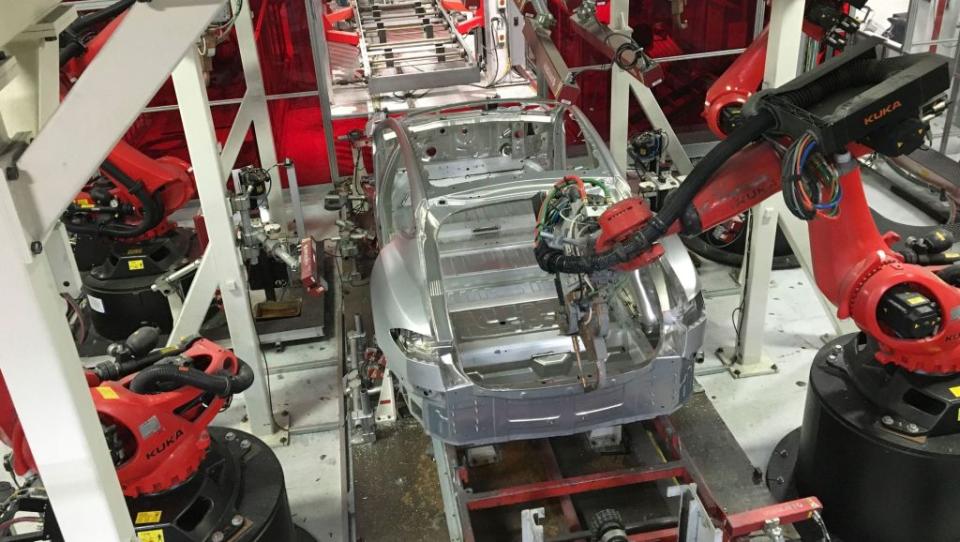The Tesla Model 3 cost $28,000 to build, German engineers say—and it still may not be profitable

German car engineers tore apart the Tesla Model 3 to see how much it costs to make the upstart electric vehicle threatening German dominance on the road. The engineers, working on behalf of German car makers, reportedly broke down four vehicles, according to the German business magazine WirtschaftsWoche (link in German). Musk called it the “best analysis of Model 3 to date.”
Test engineers came away impressed. Panasonic, the Japanese firm collaborating on Tesla’s battery factory in Nevada, brought down the share of cobalt in its Tesla battery cells from 8% to 2.8%. That’s an important line item in the cost of the car, as the cost of cobalt has been soaring.
The engineers estimate a total of $28,000 in costs to build the Model 3: $18,000 for materials and $10,000 for labor and production. “If Tesla manages to build the planned 10,000 pieces a week, the Model 3 will deliver a significant positive contribution to earnings,” said one test engineer. For a car eventually supposed to retail for $35,000, that sounds like a pretty profit for Tesla.
But it won’t be, argues Erik Gordon, a professor at the University of Michigan’s Ross School of Business. The margins on the Model 3 must still pay for a cost structure that legacy carmakers don’t have, including planned factory expansions, new automation investments, and its own dealership network. While Tesla has its own advantages, like integrated solar and energy storage products and no costly pension liabilities, the company is counting on fat gross margins of 25% to stay in the black. (Ford by contrast has 10% margins.)
The $28,000 estimate for building the Model 3 “shows there’s some possibility of making money at the low end,” said Gordon. “But it actually doesn’t leave very much [money] per car for all the other expenses. If they’re selling it for less than $50,000, I don’t think it’s a good business.”
The most expensive problem the electric carmaker faces is the ballooning cost of automation at its Fremont, California, factory. CEO Elon Musk boasted in 2016 that Tesla’s highly automated Fremont facility would be the “most advanced” car factory on the planet. He’s since admitted Tesla overreached, and had to rip out parts of the assembly line.
“We had this crazy, complex network of conveyor belts,” Musk said in a CBS interview aired in April. “And it was not working, so we got rid of that whole thing.” The company bought the German automation company Grohmann to help get things back on track.
Related Video: Tesla That Crashed was on Autopilot
Watch news, TV and more on Yahoo View.
The supposed cost advantage is turning into a financial sinkhole, argues the Wall Street firm Bernstein Research. “Tesla seems to be spending over 2x what a normal [auto manufacturer] would invest per unit of installed capacity,” the March 28 report stated, citing $2 billion in recent facility investments. “The reason Tesla has spent all this money, the reason it bought Grohmann and the reason it can’t build Model 3s are all linked. Tesla has tried to hyper-automate Model 3 production.”
Automating final assembly may raise costs and lower quality
In theory, automating final assembly should make Tesla’s factories more efficient. Historically, it’s been a fiasco. European, American, and Japanese carmakers have all pulled back on automation during the final stages of manufacturing, not increased it. Up until now, at least, fitting body panels and installing windshields are delicate movements best done by humans, not robots.
Of course, that may not be true today given advances in robotics, computer vision, and machine learning. Musk has made this the centerpiece of Tesla’s strategy to beat the big carmakers. Outdated assembly lines can only lumber along as fast at the slowest human workers. “Why shouldn’t it at least be jogging speed?” Musk said in a 2017 earnings call.
Musk made highly automated factories the focal point of Tesla’s mass-production vision. “The most important point I want to make is [that] the true problem, the true difficulty, and where the greatest potential lies is building the machine that makes the machine,” he told investors at Tesla’s 2017 annual meeting (video 2:20). “In other words, building the factory … like a product” would deliver a “10-fold improvement” in productivity.
So far, those improvements have not materialized. Instead, assembly-line delays have wildly thrown off Tesla’s original forecast of 20,000 Model 3s per week by 2018. Tesla manufactured about 2,000 Model 3 vehicles for three consecutive weeks during the second quarter, peaking at 2,270 in one week in April. With recent improvements, Tesla now plans to hit 5,000 units per week by mid-summer, the point at which Musk says the Model 3 can be profitable.
The company must now either iron out its automation issues, or integrate human workers into an assembly line not originally designed for them while containing costs. Gordon is skeptical Tesla can produce the Model 3 for the estimated $10,000 in the foreseeable future. “The labor [costs] are likely to get worse, not better,” he said.
With the company facing a huge cash crunch, and potentially crippling manufacturing issues, Tesla is focused exclusively on selling higher-end Model 3 configurations. That makes business sense for now. But it’s no guarantee Tesla’s production costs will go down enough to make a $35,000 Model 3 profitable.
Sign up for the Quartz Daily Brief, our free daily newsletter with the world’s most important and interesting news.
More stories from Quartz:
The big Visa disruption highlights the risks of our electronic payment future
Step aside Trudeau, Spain’s new prime minister is nicknamed “Mr. Handsome”

